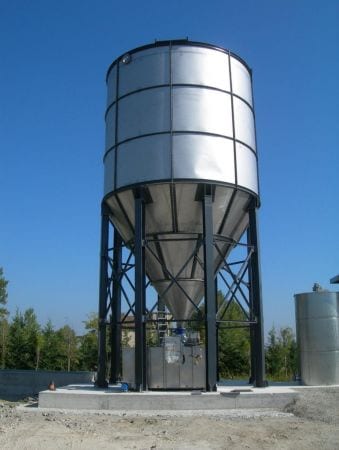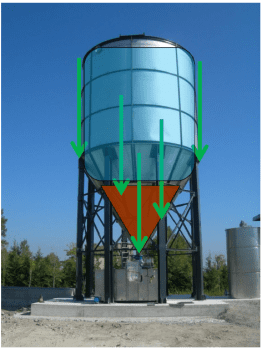
Deep Cone Water Clarifier, or decanter clarifiers, are a type of vertical thickener used in the clarifier wastewater treatment process. Unlike the filtration carried out by the filter press, the clarification is a continuous process that separates water from the solid particles suspended into it. Matec can provide customers with any type of decanters, by designing and manufacturing vertical and horizontal ones made of stainless steel or concrete.
Did you know Deep Cone Clarifiers are free of maintenance? Our Matec Deep Cone Water Clarifier has no moving parts, rake systems, suction, or pumping mechanics. As a matter of fact, they are the most efficient wastewater clarifiers in the industry today!
The Matec vertical decanters are based on the principle of static decantation and the natural precipitation of suspended solid particles. While decantation occurs, the solid particles sink down to the bottom of the structure. During this, the clean water overflows into the drainage system at the top and discharges in a clean water tank or pit.
When adding the flocculant, the sedimentation of the sludge at the bottom of the silo speeds up, simultaneously while the custom design and dimensions create a water column. Then this presses over the sludge and guarantees the correct thickness of the mud.
Matec develops the shape of the vertical decanter, the proportion between the cone, and the upper cylinder based off years of experience in waste water filtration.
Consequently, the cone’s inclination degree perfects the thickening of the mud. Also, the upper cylinder can also be used as an extra stocking space.
Learn about how Deep Cone Clarification differs from Rake Style Clarifiers: Deep Cone Vs. Rake Style Clarifiers
Available Materials for Internal Parts
Mixing Chamber
The mixing chamber is a cylindrical pipe that suspends in the center of the tank at the top. Feeding enters the mixing chamber through a T-piece manifold with 45° outlet bends, each facing 30° down, providing good mixing and dispersion of flocculant which adds directly into the mixing chamber as well. Feeding particles will exit the bottom of the mixing chamber achieving total flocculation.
Overflow Drainage Channel
The overflow launder has V- notches cut all round. Additionally, its height is adjustable, and it is put between the mixing chamber and the vertical side of the THICKNER.
We have thick mud for two reasons:
Because of this, the result is 3 zones of settling – clean water on the top, active settling in the middle and concentrates mud at the bottom.
With the opening of the discharge valve, the mud easily moves to your filter press for further dewatering.

Nick Piskura is the Marketing and Web Development Specialist at ChemREADY who utilizes expertise in digital marketing strategies to provide knowledgeable insights in each segment of our business. Nick provides insights through web development and multimedia resources that support ChemREADY’s full range of services, including Legionella management, ANSI/AAMI ST108 compliance, boiler and cooling tower treatment, wastewater processing, and industrial water quality solutions.